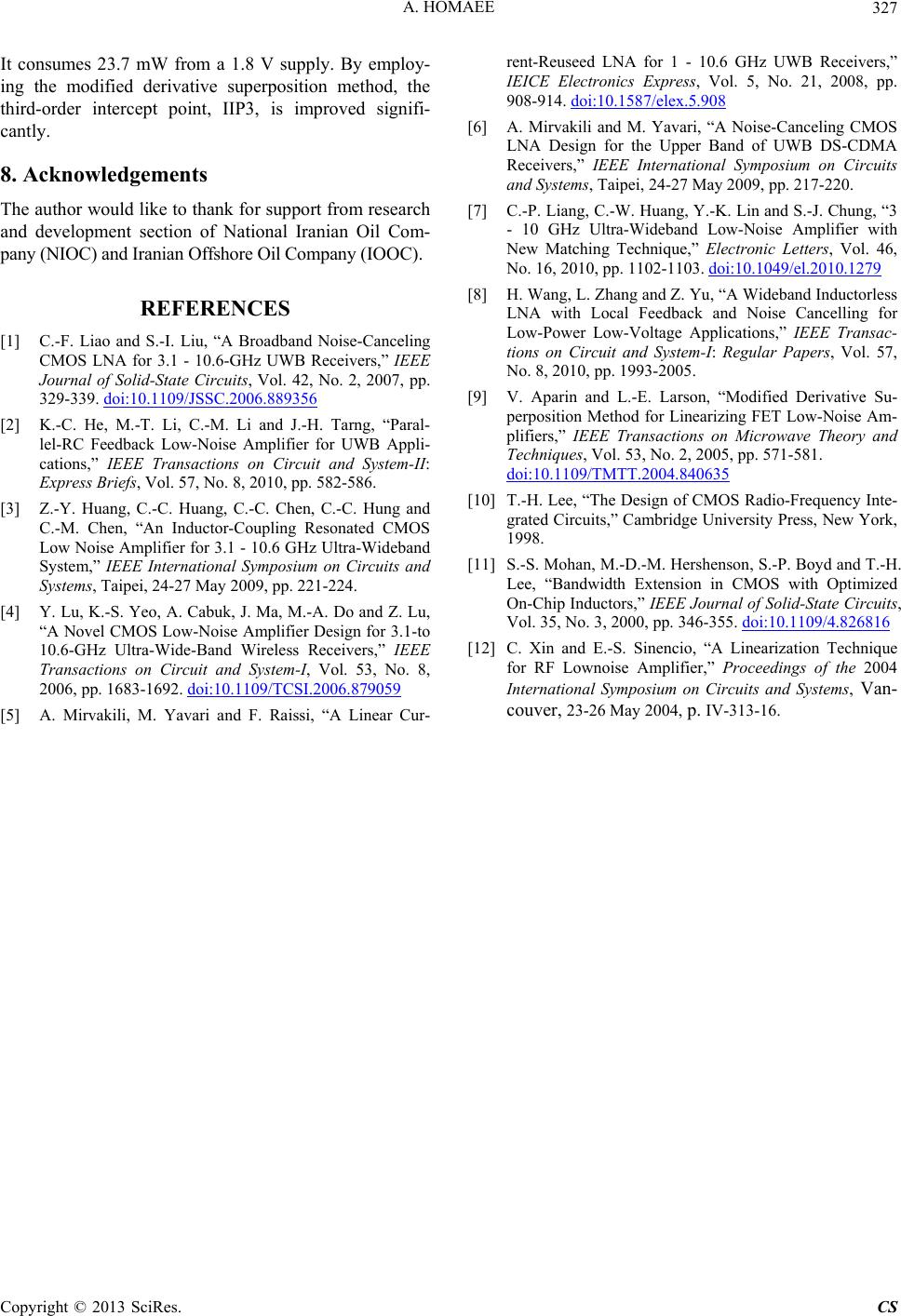
A. HOMAEE 327
It consumes 23.7 mW from a 1.8 V supply. By employ-
ing modifiative osition method, the
hird-order intepoint, IIP3, is improved signifi-
or would like to thank for support from research
and development section of National Iranian Oil Com-
hore Oil Company (IOOC).
CMOS LNA for 3.1 - 10.6-GHz UWB Receivers,”
Journal of Sol2, No. 2, 2007, pp.
329-339. doi:10.1109/JSSC.2006.889356
rent-Reuseed LNA for 1 - 10.6 GHz UWB Receivers,”
ICE s Eol. . 21, 2 pp.
8-914 87 8
the ed deriv
rcept
superp
t
cantly.
8. Acknowledgements
The auth
pany (NIOC) and Iranian Offs
REFERENCES
[1] C.-F. Liao and S.-I. Liu, “A Broadband Noise-Canceling
IEEE
id-State Circuits, Vol. 4
82-586.
3, No. 8
[2] K.-C. He, M.-T. Li, C.-M. Li and J.-H. Tarng, “Paral-
lel-RC Feedback Low-Noise Amplifier for UWB Appli-
cations,” IEEE Transactions on Circuit and System-II:
Express Briefs, Vol. 57, No. 8, 2010, pp. 5
[3] Z.-Y. Huang, C.-C. Huang, C.-C. Chen, C.-C. Hung and
C.-M. Chen, “An Inductor-Coupling Resonated CMOS
Low Noise Amplifier for 3.1 - 10.6 GHz Ultra-Wideband
Sys te m, ” IEEE International Symposium on Circuits and
Systems, Taipei, 24-27 May 2009, pp. 221-224.
[4] Y. Lu, K.-S. Yeo, A. Cabuk, J. Ma, M.-A. Do and Z. Lu,
“A Novel CMOS Low-Noise Amplifier Design for 3.1-to
10.6-GHz Ultra-Wide-Band Wireless Receivers,” IEEE
Transactions on Circuit and System-I, Vol. 5,
2006, pp. 1683-1692. doi:10.1109/TCSI.2006.879059
[5] A. Mirvakili, M. Yavari and F. Raissi, “A Linear Cur-
IE
90
Electronic
.
xpress, V
/elex.5.90
5, No008,
doi:10.15
009, pp. 217-220.
79
[6] A. Mirvakili and M. Yavari, “A Noise-Canceling CMOS
LNA Design for the Upper Band of UWB DS-CDMA
Receivers,” IEEE International Symposium on Circuits
and Systems, Taipei, 24-27 May 2
[7] C.-P. Liang, C.-W. Huang, Y.-K. Lin and S.-J. Chung, “3
- 10 GHz Ultra-Wideband Low-Noise Amplifier with
New Matching Technique,” Electronic Letters, Vol. 46,
No. 16, 2010, pp. 1102-1103. doi:10.1049/el.2010.12
,
005, pp. 571-581.
[8] H. Wang, L. Zhang and Z. Yu, “A Wideband Inductorless
LNA with Local Feedback and Noise Cancelling for
Low-Power Low-Voltage Applications,” IEEE Transac-
tions on Circuit and System-I: Regular Papers, Vol. 57
No. 8, 2010, pp. 1993-2005.
[9] V. Aparin and L.-E. Larson, “Modified Derivative Su-
perposition Method for Linearizing FET Low-Noise Am-
plifiers,” IEEE Transactions on Microwave Theory and
Techniques, Vol. 53, No. 2, 2
doi:10.1109/TMTT.2004.840635
[10] T.-H. Lee, “The Design of CMOS Radio-Frequency Inte-
grated Circuits,” Cambridge University Press, New York,
1998.
[11] S.-S. Mohan, M.-D.-M. Hershenson, S.-P. Boyd and T.-H
Lee, “Bandwidth Extension in CMOS with Optimized
On-Chip Inductors,” IEEE Journal of Solid-State Circuits,
Vol. 35
.
, No. 3, 2000, pp. 346-355. doi:10.1109/4.826816
[12] C. Xin and E.-S. Sinencio, “A Linearization Technique
for RF Lownoise Amplifier,” Proceedings of the 2004
International Symposium on Circuits and Systems, Van-
couver, 23-26 May 2004, p. IV-313-16.
Copyright © 2013 SciRes. CS